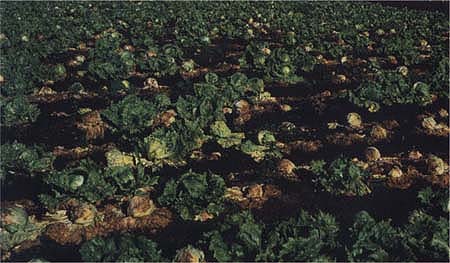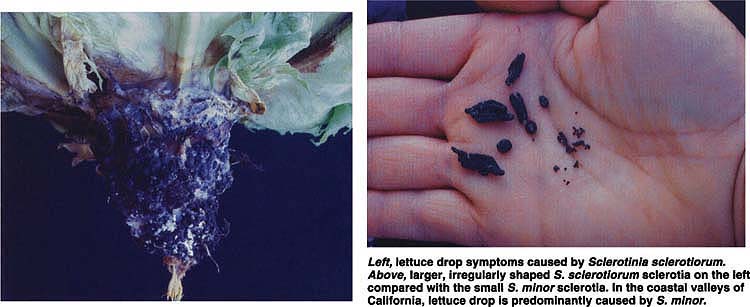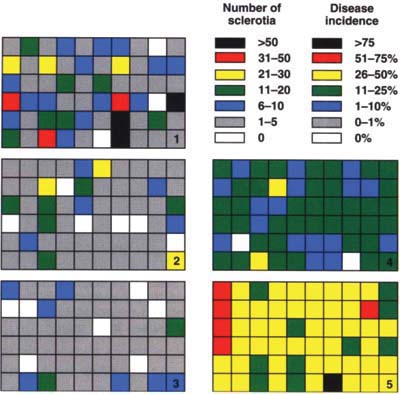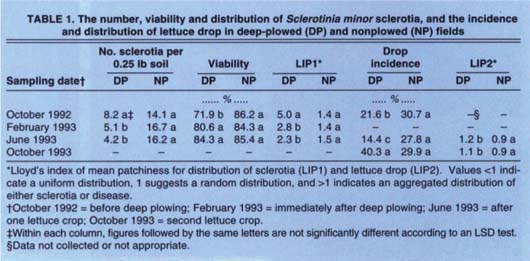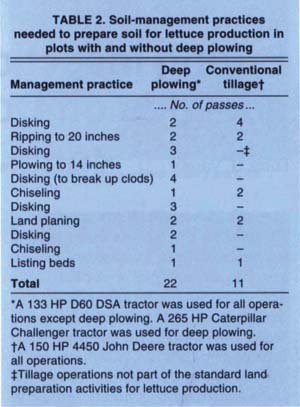All Issues
Deep plowing exacerbates lettuce drop in Salinas Valley
Publication Information
California Agriculture 50(5):30-33. https://doi.org/10.3733/ca.v050n05p30
Published September 01, 1996
Abstract
Deep plowing is unlikely to be a successful disease management strategy for lettuce drop in the high-inoculum-density fields of the Salinas Valley. Research shows that the deep-plowing procedure may change the distribution of soilborne sclerotia, ultimately resulting in higher disease incidence.
Full text
This field is infected by Sclerotinia minor, which causes lettuce drop. The disease causes a soft watery rot of both head and leaf lettuce that results in plant collapse and death.
Lettuce drop is an important disease throughout the lettuce-growing areas of California. The disease causes a soft watery rot of both head and leaf lettuce that results in plant collapse and death. Lettuce drop is caused by two species of Sclerotinia: S. sclerotiorum and S. minor. The two species are generally differentiated on the basis of sclerotia size, and they require different conditions for infection and differ in their mode of infection. In the coastal valleys of California, lettuce drop is predominantly caused by S. minor.
S. minor survives in soil as sclerotia that seldom produce the spore-producing structures called apothecia. All infections are caused by direct germination of sclerotia, and thus S. minor is strictly a soilborne pathogen. Large numbers of sclerotia are produced in colonized tissues of lettuce, and disease incidence is correlated with the number of these sclerotia in the soil. The majority of lettuce drop infections are caused by sclerotia located in the top 3.5 inches of soil and within about 0.75 inches of plant crowns.
Survival of S. minor sclerotia in soil is affected primarily by soil water and burial depth. Sclerotia either disintegrate or fail to germinate in very wet soils. They survive better in moderately moist soils, but their germination decreases progressively with time and depth of burial. Also, if sclerotia are moved from the top 4 inches of soil to depths greater than 4 inches, they are unable to cause lettuce drop infections.
With these principles in mind, deep plowing was developed as a disease-management strategy, the object being to bury sclerotia at depths of 10 to 12 inches from the surface in order to reduce the number of sclerotia in the top 8 inches of soil. A specially designed mold board plow, which inverts the soil profile to a depth of 12 inches, has been used as a disease-management tool since the early 1980s. Growers deep plow highly infested fields about once every 3 to 5 years, but have noticed a general lack of desirable levels of disease control in these fields.
Left, lettuce drop symptoms caused by Sclerotinia sclerotiorum. Above, larger, irregularly shaped S. sclerotiorum sclerotia on the left compared with the small S. minor sclerotia. In the coastal valleys of California, lettuce drop is predominantly caused by S. minor.
Although the utility of this strategy is known intuitively, no data are available to confirm its desired effects or to document the optimum frequency of deep plowing to prevent recolonization of the top 4 inches of soil by S. minor. This is important particularly in areas such as the Salinas Valley where lettuce has been grown continually for over 75 years, and where the likelihood of viable sclerotia in the different soil profiles is expected to be very high. This study was undertaken to compare the density, distribution and viability of sclerotia before and after deep plowing and to evaluate the effects of deep plowing on the incidence of drop in succeeding lettuce crops.
Field experiment
The study was located in a 13.5-acre commercial field in Salinas that has a history of lettuce cultivation since the 1930s. We determined the chemical characteristics of the soil, a silty clay. There was little variation in any of the measured soil characteristics across the four replications in the deep-plowed field. The field had a history of very high incidence (percentage of diseased plants) of lettuce drop caused by S. minor. In November 1992, an area of 132 feet by 334 feet was flagged in the field to facilitate precise location of the area for repeated sampling. This area was subdivided into four replicate plots of 132 feet by 79 feet, with a 6.6-foot space between replications. Each plot was further subdivided into 60 contiguous subplots of 13.2 feet by 13.2 feet. Before and after deep plowing, soil samples from six random sites in each subplot were collected using a 1-inch diameter soil probe to a depth of 6 inches and bulked. The field was then disked, ripped and disked again before deep plowing. A mold board plow driven by a 265 HP Caterpillar Challenger tractor was used for deep plowing to a depth of 14 inches.
Soil samples were collected from the 0-to-6-inch layer in February 1993 to study the immediate effects of deep plowing on the distribution and density of S. minor sclerotia from each of the subplots, as outlined previously. Soil samples were again collected from each of the subplots in June 1993, after the first lettuce crop, to determine the recolonization potential of the deep-plowed soil.
The next step was to record changes in the density, distribution and viability of S. minor sclerotia, as well as the incidence of lettuce drop in a field with comparable incidence of lettuce drop but with tillage practices (conventional tillage) common to lettuce production (without deep plowing). An area of 132 feet by 334 feet was demarcated. This area was subdivided into four replicate plots of 132 feet by 79 feet, with a 6.6-foot space between replications. Each plot was further subdivided into 60 contiguous subplots of 13.2 feet by 13.2 feet. Soil samples from these quadrats were collected at the same time as those from the deep-plowed field and processed similarly. The soil texture in this field was also a silty clay, and there was little variation in any of the measured soil characteristics across the four replications in this field.
Testing for sclerotia
All soil samples were air dried for 4 weeks on greenhouse benches before processing. Aliquots of 0.25 lb soil from each subplot were soaked in a 1% Calgon solution for 5 minutes, then assayed for sclerotia using the modified wet-sieving technique. The soil fraction remaining on the sieve was examined and the number of sclerotia recovered was counted using a stereo-microscope.
Sclerotia recovered from each subplot were surface-disinfested in 1% sodium hypochlorite solution for 3 minutes, air dried for 3 to 5 hours and plated on 2% water agar. The plates were incubated for 3 to 5 days, after which the number of germinated sclerotia was recorded. Viability of sclerotia was expressed as a percentage of the total recovered sclerotia.
Figs. 1–5. Distribution maps of Sclerotinia minor sclerotia (left panel) and lettuce drop incidence (%) (right panel) in various discrete classes (numbers of sclerotia per 0.25 lb soil or percentage of plants showing lettuce drop symptoms), indicated by different colored boxes: 1. Distribution of sclerotia before deep plowing. 2. Distribution of sclerotia immediately after deep plowing. 3. Distribution of sclerotia at the end of the first lettuce crop after deep plowing. 4. Distribution of drop in the first lettuce crop immediately after deep plowing. 5. Distribution of drop on the second successive lettuce crop after deep plowing.
Effects of deep plowing
Spatial distribution maps for both sclerotia and lettuce drop incidence were generated for each sampling period for the deep-plowed field. To record the changes in the number of sclerotia per 0.25 lb soil in different subplots during the three sampling periods, we calculated the cumulative frequency of subplots in frequency classes 0,1–5, 6–10, 11–20, 21–30, 31–50 and >50 (sclerotia/0.25 lb soil). The aggregation index, Lloyd's index of mean patchiness (LIP), was calculated for both sclerotia and lettuce drop incidence for each sampling period for the plots with or without deep plowing. (When LIP is 1, the distribution is random; when it is <1, it is uniform; when it is >1, it is aggregated.) To determine the relationship between the LIP and the mean number of S. minor sclerotia at different sampling periods, the LIP values for the number of sclerotia at different sampling periods were plotted against the corresponding mean number of sclerotia. Least significant difference tests were used to compare LIP for sclerotia and lettuce drop incidence among the different sampling periods in plots with or without deep plowing.
The number of sclerotia in the sampled subplots before deep plowing varied between 0 and 201, with a mean of 8.2 per 0.25 lb soil (table 1). Spatial distribution maps indicated a highly aggregated pattern for sclerotia before deep plowing (fig. 1). This was also indicated by the calculated LIP values. Results from the four replications were similar and therefore data from only one replication are presented.
Deep plowing reduced the number of sclerotia significantly (P ≤ 0.05) in the sampled subplots, to a mean of 5.1 per 0.25 lb soil with a range of 0 to 60. However, it also altered the distribution of sclerotia. The sampled subplots after deep plowing showed greater uniformity in the distribution of sclerotia than prior to deep plowing (fig. 2). Even though the calculated LIP values indicated an aggregated pattern of sclerotia, the values were significantly lower (P ≤ 0.05) after deep plowing than prior to deep plowing. The mean number of sclerotia per 0.25 lb soil in samples collected at the end of the first lettuce crop after deep plowing was 4.2 (range 0–31) and was not significantly different (P ≤ 0.05) from the mean number of sclerotia immediately after deep plowing. The spatial distribution maps showed less aggregated patterns of sclerotia than for the two previous sampling periods (fig. 3). The LIP for the sampling period after deep plowing was significantly lower than that calculated for prior to deep plowing (P ≤ 0.05), and was lower but not significantly different from the LIP immediately after deep plowing.
Deep plowing altered the distribution of sclerotia from a highly aggregated pattern to less aggregated patterns approaching random distribution during the sampling period reported in this study. Before deep plowing, there were 97 subplots with more than 5 sclerotia. Immediately after deep plowing, however, only 29 subplots had more than 5 sclerotia, and after one lettuce crop, there were 49 subplots with more than 5 sclerotia per 0.25 lb soil. This potentially increased the chance of a greater number of lettuce plants becoming infected by the pathogen.
The mean viability (%) of recovered sclerotia from subplots after deep plowing was significantly greater (P ≤ 0.05) than that prior to deep plowing. Although the percentage of viable sclerotia recovered after one crop that followed deep plowing was higher than in samples collected immediately after deep plowing, the difference was not statistically significant.
In contrast, the number of sclerotia and their viability in the nonplowed field varied little between sampling periods (table 1). However, the numbers of sclerotia at each sampling period were significantly higher in the nonplowed field than in the deep-plowed field. The distribution of sclerotia in the nonplowed field was aggregated and changed little between tillage operations, and as shown in table 1, the LIP values for the different sampling periods were not significantly different (P ≤ 0.05).
Effects on lettuce drop incidence
Prior to deep plowing, the incidence of lettuce drop was recorded at maturity in 20 random subplots of 13.2 feet by 13.2 feet in the area where soil was sampled. In two successive lettuce crops immediately after deep plowing, disease incidence was recorded at maturity in each subplot from which soil samples were collected, and expressed as a percentage. During both seasons, after deep plowing, the lettuce cultivar ‘Salinas’ was planted according to commercial practice. The mean lettuce drop incidence on crops before and after deep plowing was compared using the least significant difference test (P ≤ 0.05). Similarly, lettuce drop incidence in each subplot was recorded in the nonplowed plots.
The crop prior to deep plowing had a mean lettuce drop incidence of 22%, with a range of 16% to 35%. Mean incidence of drop in the first lettuce crop after deep plowing was significantly lower (P ≤ 0.05) than incidence in the crop prior to deep plowing (table 1). However, the mean incidence of lettuce drop in the second successive lettuce crop after deep plowing was nearly twice as great as the incidence in the crop prior to deep plowing, and nearly three times as great as the incidence in the first crop after deep plowing.
The spatial distribution maps of lettuce drop incidence show a uniform distribution on both crops after deep plowing (figs. 4 and 5). Results from all replications were similar, and therefore only one is presented. A uniform distribution is also indicated by the calculated LIP values (?1) for both sampling periods, which were not significantly different (P ≥ 0.05).
In contrast, the first lettuce crop in the nonplowed field had a mean lettuce drop incidence of 30.7%, with a range of 24% to 37%. The mean drop incidences of the two succeeding lettuce crops were not significantly different. The distribution of the disease as indicated by the LIP values was uniform (table 1).
To judge the benefits of deep plowing, one must examine both the mean number of sclerotia and their distribution before and after deep plowing. This is because sclerotial distribution is a key factor in determining the reliability of inoculum density estimates. in developing soil sampling strategies and in assessing the impact of plant disease on crop yield. Examining the mean number of sclerotia alone may lead to erroneous conclusions and development of an energy-intensive disease management practice that is less than effective. Our data suggest that the benefits of deep plowing, if any, are likely to disappear within one crop after deep plowing. Alternatively, deep plowing would have to be practiced every year, which might bring sclerotia buried the previous year back up to the surface.
TABLE 1. The number, viability and distribution of Sclerotinia minor sclerotia, and the incidence and distribution of lettuce drop in deep-plowed (DP) and nonplowed (NP) fields
TABLE 2. Soil-management practices needed to prepare soil for lettuce production in plots with and without deep plowing
In addition to the questionable benefits of deep plowing in high-inoculum-density fields, deep plowing exacts a higher cost in soil management inputs. In our commercial field, deep plowing and other tillage operations required 22 tractor passes to prepare the soil for lettuce production. In contrast, the standard tillage operations that do not include deep plowing required only 11 tractor passes (table 2). Deep plowing makes the soil very cloddy and unsuitable for commercial lettuce planting. Preparing the soil for commercial lettuce planting requires greater than normal tillage operations that potentially distribute the sclerotia horizontally in a field, increasing the likelihood of a greater number of plants becoming infected.
Conclusions
Although a significant reduction in the mean number of sclerotia was recorded after deep plowing, sclerotial distribution was modified from a highly aggregated pattern to a less aggregated pattern. All other soil factors and crop-production practices being the same, this perhaps increased the likelihood of a greater number of plants becoming infected, and consequently a significantly higher incidence of lettuce drop in the second successive crop after deep plowing. Deep plowing is therefore unlikely to be an effective option for lettuce drop management in the high-inoculum-density fields in the Salinas Valley.



